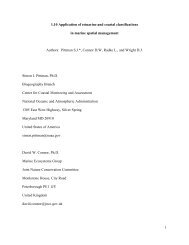GEO/OC 103 Exploring the Deep… Lab 7 - Dawn Wright
GEO/OC 103 Exploring the Deep… Lab 7 - Dawn Wright
GEO/OC 103 Exploring the Deep… Lab 7 - Dawn Wright
Create successful ePaper yourself
Turn your PDF publications into a flip-book with our unique Google optimized e-Paper software.
<strong>Exploring</strong> <strong>the</strong> Ocean Environment<br />
Unit 4 – Marine Productivity<br />
biotic community — group of<br />
interdependent organisms inhabiting <strong>the</strong> same<br />
region and interacting with one ano<strong>the</strong>r.<br />
anchovies — a type of small fish, similar to<br />
sardines, that eat zooplankton.<br />
tuna — a type of large predatory fish that eat<br />
o<strong>the</strong>r fish.<br />
The preservation of each link in a food web is critical for maintaining diverse and<br />
healthy biotic communities. However, certain organisms are more critical than o<strong>the</strong>rs.<br />
1. Examine <strong>the</strong> complex marine food web in Figure 3 on <strong>the</strong> previous page.<br />
Add anchovies (A), tuna (T), and humans (H) where you think <strong>the</strong>y<br />
fit best. Draw arrows as needed to show consumption of and by o<strong>the</strong>r<br />
organisms.<br />
This question calls for speculation, so answers will vary.<br />
2. What do you think would happen if all of <strong>the</strong> autotrophs were removed<br />
from <strong>the</strong> marine food web<br />
Initially, only those heterotrophs that directly feed on <strong>the</strong>m would be affected, but soon<br />
<strong>the</strong> entire food web would collapse from <strong>the</strong> lack of primary food.<br />
3. What do you think would happen if one of <strong>the</strong> heterotrophs, such as <strong>the</strong><br />
predatory fish, were removed<br />
Removing one of <strong>the</strong> heterotrophs would have serious consequences for organisms<br />
higher on <strong>the</strong> food chain that depend on that organism for food. Some organisms would<br />
adapt, but o<strong>the</strong>rs may die off. It would also affect <strong>the</strong> organisms lower on <strong>the</strong> food<br />
chain, by not keeping <strong>the</strong>ir numbers in check.<br />
4. How do humans influence food webs<br />
Humans influence food webs as consumers, eating organisms and depleting <strong>the</strong>ir<br />
numbers; but also by modifying <strong>the</strong> environment through fisheries management,<br />
control of invasive species, pollution, destruction of habitat, etc. — making it more or<br />
less capable of supporting <strong>the</strong> biotic community and its members.<br />
respiration — process by which organisms<br />
oxidize or “burn” food, producing water and<br />
carbon dioxide.<br />
nutrients — chemical compounds that are<br />
used by bacteria and plants as <strong>the</strong> building<br />
blocks for organic material. Common nutrients<br />
include:<br />
• phosphates (PO 4-<br />
)<br />
• nitrates (NO 3-<br />
)<br />
• silica (SiO 4-<br />
)<br />
• iron (Fe 3+ )<br />
Photosyn<strong>the</strong>sis requires four key ingredients: water, sunlight, nutrients, and<br />
carbon dioxide. For marine autotrophs like phytoplankton, <strong>the</strong>re is plenty of<br />
water available in <strong>the</strong> oceans. Carbon dioxide is also abundant in ocean waters. It<br />
is released as a by-product of respiration, and it is readily absorbed into <strong>the</strong> ocean<br />
from <strong>the</strong> atmosphere. Thus, water and carbon dioxide are not limiting resources<br />
for photosyn<strong>the</strong>sis or primary productivity in <strong>the</strong> ocean. However, marine<br />
productivity is controlled or limited by <strong>the</strong> availability of <strong>the</strong> o<strong>the</strong>r two necessary<br />
resources — sunlight and nutrients.<br />
5. How do you think <strong>the</strong> availability of limiting resources might vary in <strong>the</strong><br />
ocean (Where or when would <strong>the</strong>y be high or low)<br />
This question requires speculation — answers will vary. Sunlight may be limited near<br />
<strong>the</strong> poles (during winter) and in regions that are frequently covered by clouds. Sunlight<br />
is also limited with depth, depending on <strong>the</strong> clarity of <strong>the</strong> water. Nutrients would be<br />
limited in <strong>the</strong> open ocean, far from terrestrial sources or from upwelling zones that bring<br />
up nutrients trapped in bottom sediments.<br />
126 Bounty from <strong>the</strong> sea
















